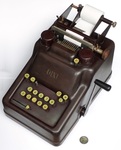
The Dixi is an adding listing machine with a Dalton-style 10-key keyboard. This is a model A, so it has 9-digit input and a 9-digit register. It can subtract but does not handle negative totals. The controls are fairly standard:
| 0-9 | Input digits |
|---|---|
| Handle | Perform operation (e.g. addition, subtraction, print, subtotal, total) |
| × | Multiplication, i.e. disable input clearing so that you can do repeated addition of the same number. Button locks down. |
| - | Subtraction. Normally single use, but can be locked down with the adjacent switch for repeated subtractions. |
| ⊲ | Non-add. Print number without adding to the register. |
| □ | Subtotal. Print current register value without clearing it. |
| ∗ | Total. Print current register value and then reset it to zero. Sometimes the button is blocked, which means you need to perform a blank cycle, i.e. pull the handle without any input number. |
| C | Cancel. Release any function button (subtotal, total, subtract, non-add) to cancel the selected operation. |
| Slider | This indicator shows how many digits have been entered so far. Can be pushed to the right to clear the input manually. |
The printing mechanism has two levers. Normally the paper is shifted up one line after every printing operation. The lever on the left disables this shifting, which is mainly used when you need to perform an empty cycle before a (sub)total. The lever on the right releases the paper to allow it to be adjusted freely by hand.
The serial number is A39590.
Aktiebolaget Dixma was founded in 1938 in Malmö, and was a daughter company of Addo. Starting in 1939 it manufactured Dixi adding machines, which were similar to the Addo-X machines, but with a Dalton-style ten-key keyboard. This means that the number keys are arranged in two rows of 5 keys, which is named after the American company that first used that type of keyboard.
In 1966 Addo was bought by Facit-Odhner, and it seems that Dixma was dissolved around that time, just like Multo was.
The Dixi adding machines were produced with four capacities: A has 9 digits, B has 11 digits, C has 8 digits, F has 7 digits. The standard versions of these models are manually driven and can subtract, but cannot print negative totals nicely (for example a total of -1 is printed as 999999999). Variations were denoted using extra letters, such as E for electrically driven models, U for models without subtraction, and N for handling negative totals. Not every combination was made, for example model F was only available as FU, and the only model with an N variant was model BN. Here is a full table:
| 7 digits | 8 digits | 9 digits | 11 digits | ||
|---|---|---|---|---|---|
| U | FU | CU | AU | Manual, no subtraction, no negative totals | |
| - | C | A (820) | B (821) | Manual, with subtraction, no negative totals | |
| E | CE | AE (820E) | BE (821E) | Electric, with subtraction, no negative totals | |
| N | BN (3821) | Manual, with subtraction, with negative totals | |||
| NE | BNE (3821E) | Electric, with subtraction, with negative totals |
A numerical naming scheme was used later that was more similar to the naming of Addo machines, and this is included in the table above.
A bookkeeping variant with a wide carriage instead of a paper roll is denoted with the suffix C, but this seems to have been available only on the high-end variants BNC (3821-C) and BNEC (3821E-C). There is also a model E calculator, but that is simply a rebadged Multo 13 pinwheel machine.
Note that the Dixi machines are basically identical to Addo-X, just with a different layout of the number keys, and a different colour scheme. The early Dixi models (such as mine above) were very similar to the Addo-X series 20, where the ink ribbon spools have individual covers. From 1950 they were like the series 40, with a two-coloured ink ribbon and a single piece of casing that covers both spools.
By the end some Dixi models had a standard 10-key keyboard, making them essentially rebadged Addo-X machines (Dixi 18111 = Addo-X 345; Dixi 28012 = Addo-X 40E; Dixi 28113 = Addo-X 341; Dixi 28123 = Addo-X 2341).
Here are the few ads and articles I found for the Dixi.
| Patent | Filing date | Publish date | Name | Description |
|---|---|---|---|---|
| CH 268,582 | 23-02-1948 | 01-09-1950 | Aktiebolaget Dixma | Calculator with two registers
See also: US 2,556,762 |
| CH 269,546 | 23-02-1948 | 16-10-1950 | Aktiebolaget Dixma | Pinwheel carry mechanism |
| CH 274,565 | 23-02-1948 | 02-07-1951 | Aktiebolaget Dixma | Multiplication mechanism |
| DE 823,052 C | 28-01-1950 | 06-12-1951 | John Lydfors; Aktiebolaget Dixma | Axle coupling
See also: CH 282,772, US 2,654,455 |
| DE 926,816 C | 04-12-1951 | 25-04-1955 | John Lydfors; Aktiebolaget Dixma | Calculator with shortcut multiplication |
| GB 713,873 | 11-01-1952 | 18-08-1954 | John Lydfors; Aktiebolaget Dixma | Differential setting mechanism |
© Copyright 2025 Jaap Scherphuis, mechcalc a t jaapsch d o t net.